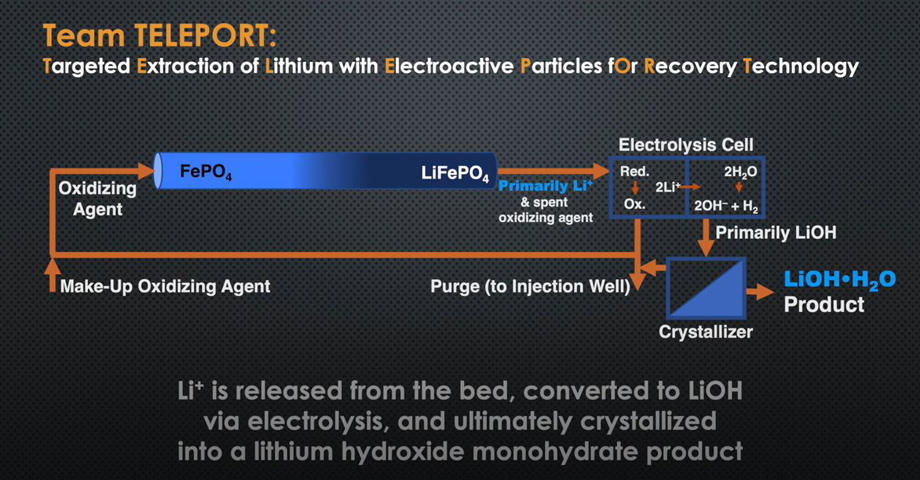
A research team led by members of the Department of Chemical Engineering faculty at the University of Virginia School of Engineering and Applied Science has found a way to extract lithium from geothermal brines — a potential answer to meeting some of the country’s critical energy needs as we transition from reliance on fossil fuels.
Lithium is an essential material in batteries for electric vehicles and grid-scale electricity storage.
Associate professors Geoffrey Geise and Gary Koenig and assistant professor Gaurav “Gino” Giri, with industry partner PowerTech Water, placed second in the U.S. Department of Energy’s American-Made Geothermal Lithium Extraction Prize in which they developed a prototype of their process, called Targeted Extraction of Lithium with Electroactive Particles for Recovery Technology (TELEPORT).

A Cleaner Alternative for a Clean-Energy Supply Chain
The DOE commissioned the prize to speed development of direct extraction of lithium from California’s Salton Sea to establish a domestic supply of the element that can be recovered safely and economically. The U.S. currently imports about 99% of its supply, according to a DOE news release announcing the competition’s winners.
Salton Sea geothermal power plants pump tens of thousands of gallons per minute of hot water containing salt, lithium and other minerals to the surface from deep wells to produce energy. These geothermal brines — a clean-energy byproduct — could supply 600,000 tons of lithium annually, according to the DOE, a volume exceeding U.S. demand today.
The problem is, conventional extraction by evaporation pools requires enormous land and water use. Finding the right technique for separating lithium from geothermal brines could reduce the consumption of groundwater, harmful chemicals and ecological disruptions associated with evaporative or land-mining methods in other locations.
The Geothermal Lithium Extraction Prize, administered by the National Renewable Energy Laboratory (NREL) and funded by DOE’s Geothermal Technologies Office, aimed to address this challenge by incentivizing academic researchers, entrepreneurs and industry partners to innovate new processes.
The TELEPORT Lithium Extraction Process
The TELEPORT process starts by flowing the brine — a primordial brew of mostly unwanted minerals and metals — through tubes packed with a crystalline material that acts like a lithium sponge. Atoms present in the material’s particles contain void space, explained Geise, the team captain.
Under conditions present in the brine solution, the particles will undergo a reaction that allows lithium into the material and to fit into those voids.
“The electrochemistry is nearly identical to what happens in a battery. You’re moving ions into the material similarly to the movement of ions into a battery cathode during discharge,” Geise said. “The molecular space within the particles is perfectly sized for lithium ions, and other contaminant ions just don’t fit well.”
This concentrates the lithium into a compact space until the next stage of the process and allows for immediate removal of lithium from the brine.

“So we manage to quickly get rid of the ions that are problematic from the brine perspective,” Geise said. “We also greatly reduce the physical space needed for the subsequent purification process, which is economical, and the way that our special sponges work is unique compared to similar approaches because they minimize the need to add acids or other chemicals.”
That last point matters because the leftover brine will be injected back into the ground and could contaminate the wells.
The lithium is released from the sponges as lithium chloride or lithium sulfate in a solution, which is converted in TELEPORT’s next stage to bicarbonate or hydroxide, the desired form of lithium electrolyte for use in batteries.
The conversion is made in an electrolysis cell by pulling the solution across a selective membrane using electricity. This leaves the undesired molecules on one side of the cell and pairs the lithium with bicarbonate, or in Team TELEPORT’s case, hydroxide, on the other.
The final TELEPORT stage dries the lithium hydroxide that comes out of the membrane process — by now reduced in volume by many orders of magnitude from the original brine — into the powdered crystal material manufacturers need to make a battery cathode.
Integrating Expertise for Success
Two years ago, UVA Engineering’s Team TELEPORT was a semifinalist from an initial field of 40 teams in the competition’s first phase. Semifinalists won $40,000 to develop their concepts in the second phase — from which Team TELEPORT emerged as one of five finalists with $280,000 in prize money to fund the work in phase three: Fabricate and test their prototypes.
Three final winners were chosen, with a first-place prize of $1 million and two second-place prizes of $500,000 awarded to continue the teams’ research.
Team TELEPORT’s three-phase approach capitalizes on their labs’ respective strengths — Geise’s work with advanced polymer membranes, Koenig’s expertise in the electrochemistry of battery systems and Giri’s use of crystallization for purification and separations technologies.
“Others have suggested lithium extraction and conversion via an all-membrane process or other particle-based approaches,” Geise said.
“Our idea was that coupling the particle- and membrane-based processes together could lead to a unique, economic and environmentally attractive solution.”